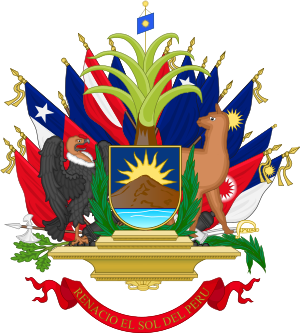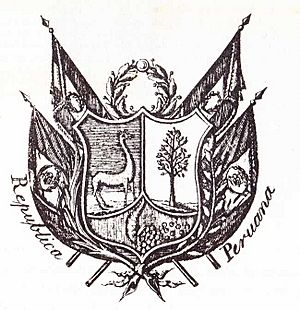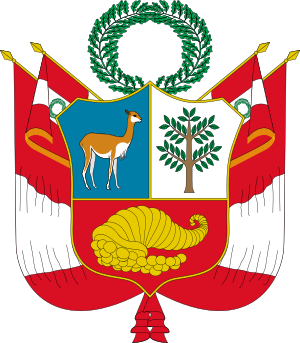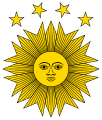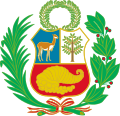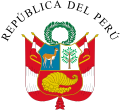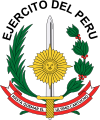Coat of arms of Peru facts for kids
Quick facts for kids Coat of arms of Peru |
|
|---|---|
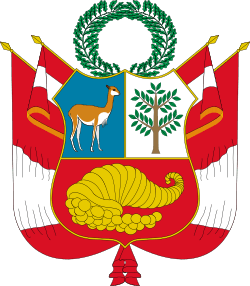 |
|
| Versions | |
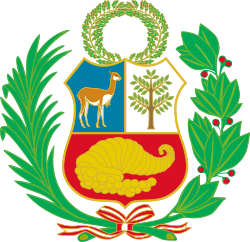
The Coat of arms (Escudo de armas) as used in the National flag.
|
|
| Armiger | Republic of Peru |
| Adopted | 25 February 1825 |
| Supporters | Flag of Peru |
| Other elements | When used on the National Flag, the Coat of arms (Escudo de armas) is surrounded by a wreath of palm branch one on the left and a laurel one on the right tied by a red and white ribbon. |
The Coat of arms of Peru is a special symbol for the country of Peru. It's like a unique picture that represents the nation. There are actually four different versions of this coat of arms, each used for a specific purpose.
Contents
What the Coat of Arms Looks Like
The law in Peru describes the coat of arms very clearly. It's a shield divided into three parts.
- The top right part is light blue. It shows a vicuna, which is an animal similar to a llama, looking inwards.
- The top left part is white. It has a quinine tree on it.
- The bottom part is red and a bit smaller. It shows a cornucopia, which is a horn-shaped basket, spilling out gold coins.
These symbols show the natural riches of Peru. They represent animals, plants, and minerals found in the country.
Above the shield, there's a special crown called a civic crown. On each side of the shield, there's a Peruvian flag and a standard (another type of flag).
Different Versions of the Coat of Arms
Peru uses a few different versions of its coat of arms. Each one has a slightly different look or is used for a different reason.
The Main Coat of Arms
This version is called the Escudo de Armas. It has a palm branch on its left and a laurel branch on its right. These branches are tied together with a red and white ribbon.
Above the shield, there's a Holm oak civic crown. This crown and the branches stand for victory and glory. You can often see this version on Peruvian money, like coins and bills, and on stamps. It's also used on the state flag.
The National Coat of Arms
The National Coat of Arms, or Escudo Nacional, includes the shield. On each side of the shield, there's a full Peruvian flag and a standard.
It also has the Civic Crown on top. This version is used on the war flag. You'll also see it on all public buildings in Peru, usually with the name of the government office below it.
The Great Seal of the State
The Great Seal of the State, known as Gran Sello del Estado, uses the National Shield. Above the shield, it has the words "República del Perú" (which means "Republic of Peru") written in a half-circle.
This seal is used on important official government documents.
The Naval Coat of Arms, or Escudo de la Marina de Guerra, is special for the Peruvian Navy. It features the National Shield.
Instead of flags on the sides, it has anchors. Above the shield, there's an image of the sun. This version is used for different purposes by the navy.
History of the Coat of Arms
The Coat of Arms of Peru has changed a few times over the years. Each change tells a bit about Peru's history.
First Design (1820-1825)
The very first version of Peru's Coat of Arms was created by General José de San Martín. It was officially announced on October 21, 1820.
This first design showed a landscape with the sun rising over the Andes mountains, seen from the sea. It was surrounded by laurel branches. The shield had a blue sky, yellow sun rays, dark mountains, and a blue and green ocean.
Behind the shield, there were flags from South American nations and a banana tree. A condor bird was on the left, and a llama animal was on the right. Below it, a scroll read "Renació el sol del Perú" ("Peru's sun is reborn").
Second Design (1825-1950)
On February 25, 1825, Simón Bolívar and the Congress decided on a new design. This version was very similar to the one used today. It was designed by José Gregorio Paredes and Francisco Javier Cortés.
This new design kept the shield divided into three parts. It had the vicuña, the quinine tree, and the cornucopia spilling coins. These symbols represented Peru's natural wealth.
It also included the civic crown on top. On each side, there was a flag and a standard, just like the National Coat of Arms today.
During the Peru-Bolivia Confederation
From 1836 to 1839, Peru was part of a larger group called the Peru–Bolivian Confederation. During this time, Peru was split into two parts: South Peru and North Peru.
South Peru got a new coat of arms. It had a golden sun with four small stars above it. These stars stood for the four main regions of South Peru. North Peru continued to use the original coat of arms.
When the Confederation ended, Peru became one country again. Its original national symbols, including the coat of arms, were brought back.
Changes in 1950
The coat of arms used today is a slightly changed version of the second design. Before 1950, there were some difficulties with its design. Sometimes, parts of it were changed or left out on official seals.
The last change happened in March 1950. This was during the time General Manuel A. Odría was in charge. In this update, the shield was split differently. The bottom red section became the largest part, instead of the smallest.
At the same time, the National Coat of Arms was created as a special symbol for the government.
See also
 In Spanish: Escudo del Perú para niños
In Spanish: Escudo del Perú para niños


